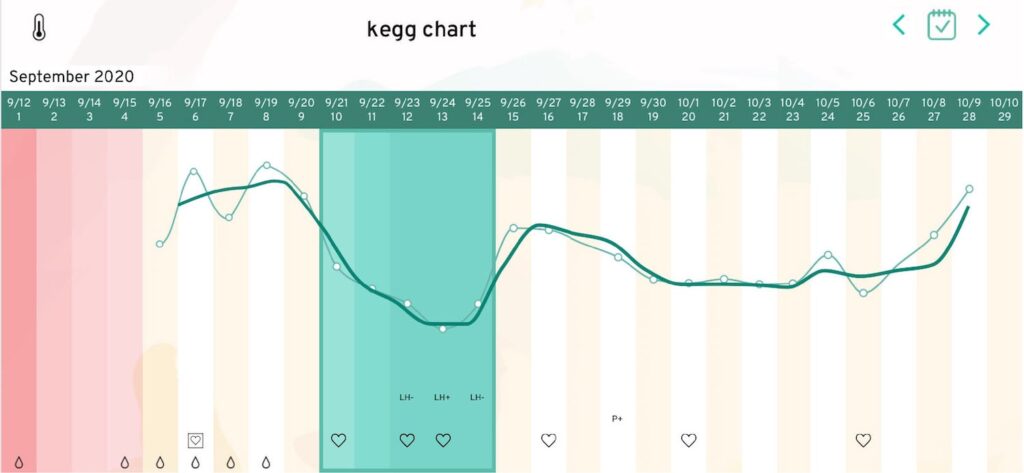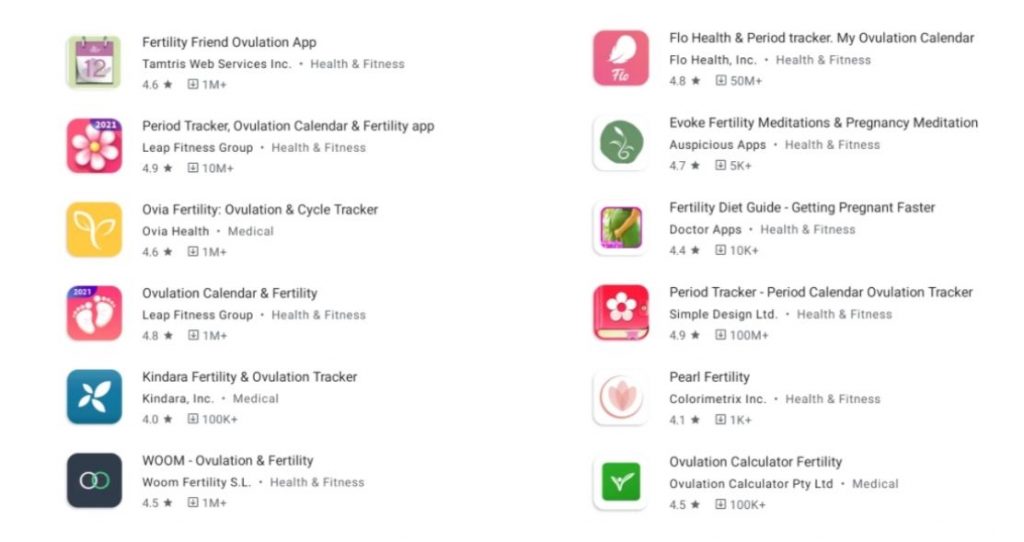The fertility tracker space can be broken up into four different areas:
1.Temperature Monitoring
2. Detecting changes in the electrolyte levels in cervical mucus
3. Urinary Hormone Measurement
4. Tracking apps
Temperature Monitoring
In the temperature monitoring space, BBT tracking (Basal Body Temperature), is unable to signal impending ovulation and requires a serious commitment. Even if you’re diligent about taking your basal body temperature as soon as you wake up every single morning, there are still other factors than can affect your body temperature and make it harder to pinpoint ovulation, such as alcohol consumption the night before, illness, allergies, travel, sleep disorders, working night shift, and some medications. Some devices operating in this space are used vaginally overnight or worn on the body overnight so the shape of these trackers may vary.

All of these new products that are based on how temperature (or heart-rate) can, under certain conditions, confirm ovulation in retrospect.
Temperature tracking is not a fool-proof method and therefore about 70% of women who track temperature also track cervical mucus with their own observations (this is the so called STM, Sympto -Thermal Method). Without the ovulation prediction in advance with BBT methods, many users miss critical time in their fertile window, when conception is most likely.
Temperature tracking is not a fool-proof method and therefore about 70% of women who track temperature also track cervical mucus with their own observations (this is the so called STM, Sympto -Thermal Method). Without the ovulation prediction in advance with BBT methods, many users miss critical time in their fertile window, when conception is most likely.
Cervical mucus trackers
Products designed to sense cervical mucus detect and display changes in the electrolyte levels in cervical mucus as they are affected by estrogen and other hormones.
These devices have a built-in proven and precise technology known as an impedance that shows the user when the cervical fluid is hospitable to sperm. Impedance technology has been proven successful at detecting ovulation for decades in farm animals and was just recently applied for human use.
We have previously analyzed the difference between kegg and other products that combine cervical mucus sensing and saliva reading.
These devices have a built-in proven and precise technology known as an impedance that shows the user when the cervical fluid is hospitable to sperm. Impedance technology has been proven successful at detecting ovulation for decades in farm animals and was just recently applied for human use.
We have previously analyzed the difference between kegg and other products that combine cervical mucus sensing and saliva reading.

But what makes kegg unique in the cervical mucus monitoring space?
Let’s start with the name, kegg: letter ‘k’ + the word ‘egg’:
We know you are trusting us with an intimate part of your body and your comfort was our top priority when we built the kegg. We came up with a small medical-grade silicone egg-shaped device that is no bigger than a tiny bottle of nail polish. Then we added the ‘k’ feature, the optional kegel exercise to support pelvic floor health and can also increase lubrication and circulation for better data collection.
kegg’s real uniqueness is in the way the device processes the data. kegg is the only product in the market that harnesses the power of cloud computing and advanced algorithms to analyze the user’s data and provide a fertile window prediction. The fertile window prediction is a 5-day window marked in green, placed at the beginning of your cycle, during which time kegg predicts your greatest likelihood of conception for your entire cycle.
kegg senses the electrolytes in your cervical mucus which correlate with the various reproductive hormones that fluctuate throughout your cycle. As the cervical fluid becomes more hospitable to sperm, the kegg readings descend on the kegg chart, showing the user that the fertile window has opened. As the fertile window comes to an end, kegg readings will then rise back up.
kegg is smart. It learns the trends of your cycle that are unique to you, to make reliable predictions, taking the guesswork out of predicting your fertile window. Every cycle has a unique trend.
We know you are trusting us with an intimate part of your body and your comfort was our top priority when we built the kegg. We came up with a small medical-grade silicone egg-shaped device that is no bigger than a tiny bottle of nail polish. Then we added the ‘k’ feature, the optional kegel exercise to support pelvic floor health and can also increase lubrication and circulation for better data collection.
kegg’s real uniqueness is in the way the device processes the data. kegg is the only product in the market that harnesses the power of cloud computing and advanced algorithms to analyze the user’s data and provide a fertile window prediction. The fertile window prediction is a 5-day window marked in green, placed at the beginning of your cycle, during which time kegg predicts your greatest likelihood of conception for your entire cycle.
kegg senses the electrolytes in your cervical mucus which correlate with the various reproductive hormones that fluctuate throughout your cycle. As the cervical fluid becomes more hospitable to sperm, the kegg readings descend on the kegg chart, showing the user that the fertile window has opened. As the fertile window comes to an end, kegg readings will then rise back up.
kegg is smart. It learns the trends of your cycle that are unique to you, to make reliable predictions, taking the guesswork out of predicting your fertile window. Every cycle has a unique trend.

Urinary Hormone Measurement
In the direct hormone measurement space, there are both devices and off-the-shelf urine dipsticks (or “pee sticks”) that look for markers in the urine. LH test strips for example, while accurate in themselves in detecting LH in the urine, do not give you an advanced prediction of upcoming ovulation, only 24-48 hours maximum before ovulation, considerably reducing the time you have for planning intercourse. Many users have “missed” valuable opportunities to conceive during the “fertile window” when waiting for the LH surge, thus decreasing the odds of conception. In addition, some women have elevated LH levels throughout their cycle, making LH testing unreliable for them. Other users will ovulate within hours of an LH surge, again limiting the time in which planned intercourse can occur. To make matters more confusing, LH often remains elevated after ovulation.
Some modern hormone measurement devices have the ability to detect elevated estrogen up to 6 days before ovulation, giving notice of the fertile window beginning but they still require urine analysis. Factors such as time of day and the concentration of the urine can impact the validity of these tests results. Estrogen can rise long before ovulation too, making pinpointing the true fertile window more difficult.
Another factor to keep in mind is that a positive LH test can not confirm ovulation. Frequently, women will have a positive LH test and NOT ovulate. It is also possible to ovulate without getting a positive LH test. It is also not uncommon for a woman to have more than one LH surge in a cycle leading to more confusion about when the true fertile window might have been.
Some modern hormone measurement devices have the ability to detect elevated estrogen up to 6 days before ovulation, giving notice of the fertile window beginning but they still require urine analysis. Factors such as time of day and the concentration of the urine can impact the validity of these tests results. Estrogen can rise long before ovulation too, making pinpointing the true fertile window more difficult.
Another factor to keep in mind is that a positive LH test can not confirm ovulation. Frequently, women will have a positive LH test and NOT ovulate. It is also possible to ovulate without getting a positive LH test. It is also not uncommon for a woman to have more than one LH surge in a cycle leading to more confusion about when the true fertile window might have been.
Fertility apps

It’s estimated that a minimum of 25-35M of American women in their reproductive age use apps for period tracking. The greatest challenge of fertility apps is that they lack accuracy because they rely on subjective-observations of their users and period predictions are based on average cycle length, historical data that the user has manually entered in the app and not real-time objective data. Ovulation is predicted according to a probability-based algorithm that is also responding to the user’s manual and subjective observations & input into the app. These methods lack objective data and analysis to help the user confidently predict the ovulation window, especially with irregular cycles.

